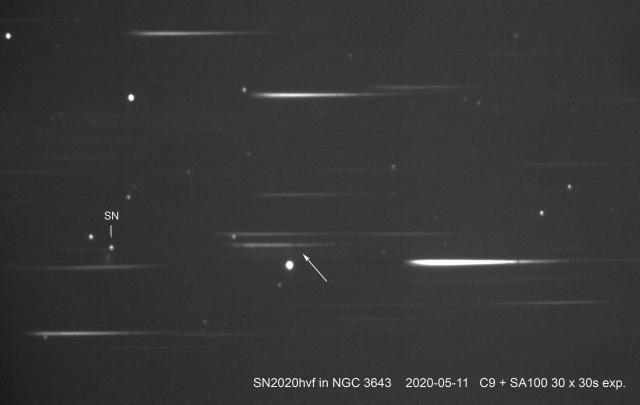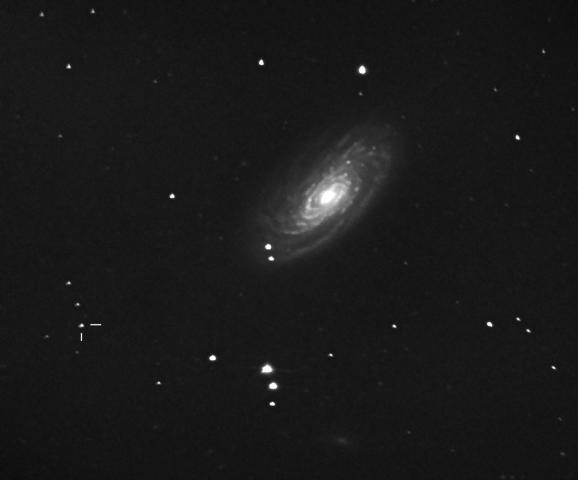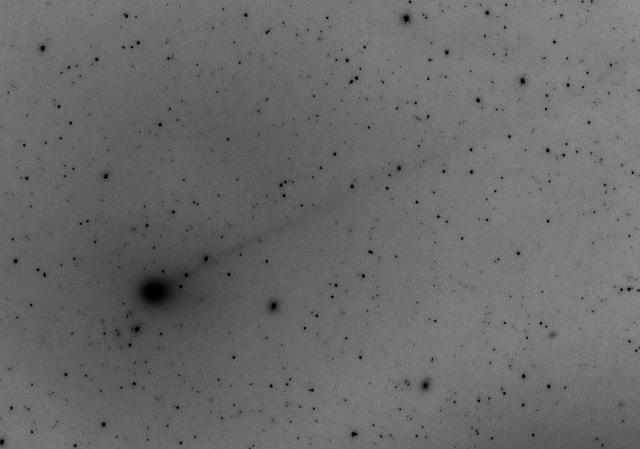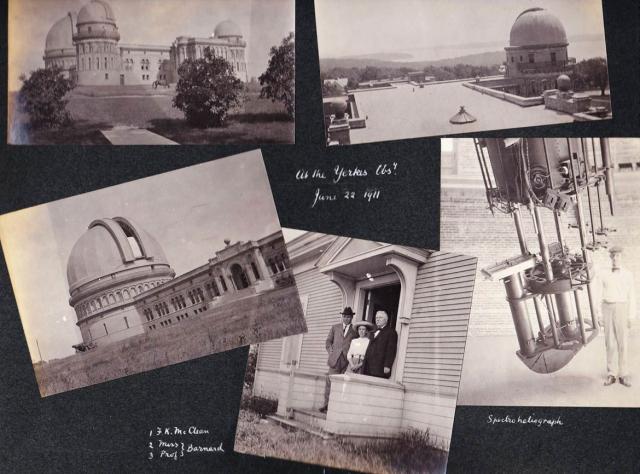Forum Replies Created
-
AuthorPosts
-
 David StrangeParticipant
David StrangeParticipantWas the image captured with a reflector or refractor? If the latter, the ring may have been caused by the star showing excess infrared emission hence out of focus with respect to other stars. Advise him to take another image of the same star field, but this time refocus on the star with the ring. If that sharpens then all the others will look like planetary nebulae – proving the point!
David
 David StrangeParticipant
David StrangeParticipantThanks for the heads up! I caught a spectrum of it last night with an SA100 & C9 30x30s exp.Rotated image 90 deg to avoid galaxy: Think I’ve caught the Si II absorption line at 6127A. Cheers, David

 David StrangeParticipant
David StrangeParticipantCongratulations! I’ve just seen Ernesto Guido’s gif animation, which is quite remarkable!
David
 David StrangeParticipant
David StrangeParticipantThere were quite a few field stars interfering within the coma tonight – sure it’s not a star?
David
23 March 2020 at 3:28 pm in reply to: Unidentified moving object in field of C/2019Y4 (ATLAS) #582138 David StrangeParticipant
David StrangeParticipantThanks David, I have had peculiar analemma type trails on hyperstar images before but this one was a very regular motion between each successive image. However, when you actually look at the artifact close up it shows a spiked appearance, so other than a Klingon starship it must have been a ghost image from that bright star!
David
23 March 2020 at 10:37 am in reply to: Unidentified moving object in field of C/2019Y4 (ATLAS) #582128 David StrangeParticipant
David StrangeParticipantHere is a two image blink comparison: start and end times: 02:14h and 02:25h 2020-03-23
https://www.dropbox.com/s/im2wjebof8mh083/C2019Y4_20200323_dgs.gif?dl=0
 David StrangeParticipant
David StrangeParticipantIt’s also been spotted by observant non-astronomers!
Just received this query, to which I have replied.
David
Comment: Dear NLO team,
I wonder if you could help me please? On Friday night (24th May) at a out 11.30pm 2 of my friends and I watched a very strange phenomenon for a good minute, from a country lane just north of Totnes in Devon. (We were sober.) We were admiring a very starry night sky, when we noticed what looked like a horizontal band of stars moving in unison from west to east across the sky. They didn’t fade away but steadily moved, with stars at the ‘front’ end more closely spaced together than those at the back, which seemed to lag. It was completely silent. There were no flashing or coloured lights to suggest it was a plane. Really odd. It almost looked like a train was gliding along up there , with lights showing from its windows . I’m guessing this was an illusion caused by something, but would be grateful if you can explain as it has mystified us! Many thanks. Karen
 David StrangeParticipant
David StrangeParticipant It’s still there. Image taken last night May 5th with 50cm in Connaught Dome at NLO with ZWO ASI 183MM. 10 x 60s exp.
It’s still there. Image taken last night May 5th with 50cm in Connaught Dome at NLO with ZWO ASI 183MM. 10 x 60s exp.David
 David StrangeParticipant
David StrangeParticipantAlso caught C/2018 V1 this morning with C8 Hyperstar and ASI183MM 20x20sec exp. Tail shows up on this reversed image.

David
 David StrangeParticipant
David StrangeParticipantAlso sad to hear this. Here’s an historic pic of Yerkes from Jim Lockyer’s photo album from 1911. Shows Frank McClean standing next to Prof. & Mrs Barnard on threshold of the fine observatory.
David

 David StrangeParticipant
David StrangeParticipantTom Field is an enthusiastic speaker and gave a free webinar on Spectroscopy with a Star Analyser to the Norman Lockyer Observatory some years ago. He used Webex, and although he was in Portland, Oregon at the time, the transmission was flawless and it was as if he was in the room giving his presentation. I am sure he is still offering this service if you can’t make this Sky&Tel webinar.
David
18 March 2016 at 9:36 am in reply to: Fireball over Southern England 2016/03/17 @ 03:16:54 UT #577284 David StrangeParticipant
David StrangeParticipantThe NLO caught it on both their North and East facing cameras:
https://www.youtube.com/watch?v=yyiZ1_8jQ9I&feature=youtu.be
and
David
 David StrangeParticipant
David StrangeParticipantAnd I hazard a guess (if those group of stars top right are the handle of the plough?)that it was painted on Oct 5th 1858 when it “passed in splendour” over Arcturus. That was also the night that the astronomer of Rousdon: Charles Grover initiated his interest in astronomy.
David
 David StrangeParticipant
David StrangeParticipantFollowing lots of requests for further information about Richard Bangay,have now added pictures to the previous text:
https://www.dropbox.com/s/mbj5oj0h1mxlbsc/Richard_Bangay.docx?dl=0
David
 David StrangeParticipantMore here:Bangay, Richard. Bpt 25th November 1834 – 24th Sept 1931
David StrangeParticipantMore here:Bangay, Richard. Bpt 25th November 1834 – 24th Sept 1931Richard Bangay son of Ellis Bangay was born in Saxlington Norfolk. In 1862 he graduated as a MD from the University of St Andrews, and also became a member of the Royal College of Surgeons during the same year. These positions he would retain to his death at the age of 98. He married Agnes Dorrington in Cheadle, Cheshire in 1880, with whom he had 7 children. During his position as a MD and surgeon he moved across the British Isles numerous times But it is his time living at Belmont in Lyme Regis, Dorset where he focused on astronomical issues building and maintaining a observatory. Bangay bought Belmont in 1883 where he would live with his increasing personal family including many extended members and servants. Here he undertook numerous expansions and redevelopments of the building including building the large observatory which overlooks Lyme Regis itself. The observatory consists of a polygonal observatory tower which still has its winding gear, now restored. Bangay was foremost a Victorian gentleman and with that respect he had interests in many fields including natural history, geology as well as astronomy. He was involved with the Dorset Natural History and Antiquarian Field club. In 1892 July he took the club to look at Sir Henry Peeks observatory at Rousden over the country boarder in Devon. As a friend of Sir Henry Peek he was a regular to Rousden and no doubt would have had access to observe the more professionally run observatory housed at the estate. By 1902 Bangay had moved to Finsbury Park, London. He was elected to the British Astronomical Association on the 18th June 1905. With the loss of his wife in 1907 he moved to Monmouthshire where he would spend the next twenty years. He died in 1931 in Buckinghamshire in relative poverty. His daughter presented his collection of astronomical books to the British Astronomical Association. Children of note were his son Raymond whom worked at the Marconi telegraph station on the Lizard in Cornwall and wrote books on telegraphy and telephony.
 David StrangeParticipant
David StrangeParticipantHello Mike,
Yes, we had fun helping out with that! Luckily, we had a lovely clear night at the NLO for the evening’s filming. Allan was on great form! I hadn’t realised until I saw the documentary that Dr. Bangay was a self educated rags-to-riches character, apparently starting out as a crow-scarer and plough boy! I have been trying to find out whether he communicated with Norman Lockyer, but the only reference I have found is from Barbara Slater’s book on “The Astronomer of Rousdon”. This is another remarkable story of a rags to riches astronomer – the life of Charles Grover. He started out as an apprentice in a brush-makers workshop, and got hooked on astronomy when he saw Donati’s comet. To cut a long story short, he ended up working for the wealthy Peeks (Peek-Frean biscuits) at Rousdoun as their resident astronomer. Now apparently, Richard Bangay was a regular visitor to Rousdon, and is mentioned in the book. He was also a keen geologist and involved with the Dorset Natural History and Antiquarian Field Club. I may have some further information passed on by George Wilkins, which I shall try and find.
David
 David StrangeParticipant
David StrangeParticipantHi Nick,
Partially clear skies at the NLO for the eclipse. BBC Spotlight were here and made a short video accessible here:
http://www.normanlockyer.com/stargazing-2015.html
Cheers,
David
-
AuthorPosts
